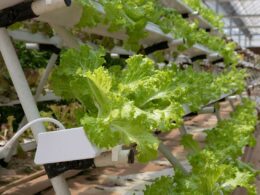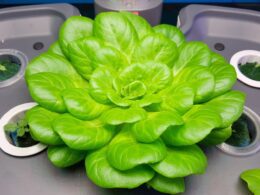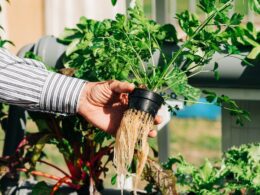Are you tired of buying lettuce from the grocery store that’s wilted and lacks flavor? Have you ever considered trying hydroponic lettuce instead of the traditional soil-grown variety?
Hydroponic lettuce is grown in a nutrient-rich water solution instead of soil, and many people argue that it is superior in taste, texture, and sustainability.
In this article, we will explore the differences between hydroponic and soil-grown lettuce and determine if one is truly better than the other. We’ll take a closer look at the nutrients in each type of lettuce, compare their taste and texture, and even delve into the environmental impact and cost of each method.
By the end, you’ll have a better understanding of whether hydroponic lettuce is worth the investment and if it can truly satisfy your craving for fresh, delicious greens.
Overview of Hydroponic and Soil Lettuce
You’re about to discover the differences between growing leafy greens in dirt and a water-based system. Lettuce, in particular, is one of the most commonly grown crops using hydroponic farming.
Unlike traditional soil farming, hydroponic farming eliminates the need for soil and replaces it with water and nutrients. Hydroponic lettuce can grow up to three times faster than soil lettuce due to the controlled environment it offers. This results in a year-round harvest, making it more sustainable.
One of the benefits of hydroponic farming is that it allows farmers to grow crops in areas where soil conditions are not ideal. Soil farming can be challenging, especially when the soil is depleted of nutrients or contains harmful chemicals. Hydroponic farming eliminates these challenges by providing plants with the necessary nutrients directly through the water. This not only results in healthier plants but also reduces the risk of pests and diseases.
In conclusion, hydroponic lettuce is better than soil lettuce in many ways. Hydroponic farming provides a controlled environment that allows for faster growth, year-round harvest, and healthier plants. It also eliminates the challenges of traditional soil farming, making it more sustainable. With the increasing demand for fresh produce, hydroponic farming is an innovative solution that offers many benefits for farmers and consumers alike.
Nutrient Comparison
You might be surprised to learn about the differences in nutrient content between these two types of growing methods. While soil-grown lettuce can be rich in minerals like iron and calcium, hydroponic lettuce often contains higher levels of vitamins like C and E.
Additionally, hydroponic systems are able to control the nutrient content of the water, ensuring that the plants receive precisely what they need to thrive. If you’re concerned about health benefits, it’s worth noting that hydroponic lettuce can be grown without the use of pesticides or herbicides, making it an ideal option for those who want to limit their exposure to harmful chemicals.
Additionally, hydroponic systems use significantly less water than traditional farming methods, making them a more environmentally-friendly option overall.
So, is hydroponic lettuce better than soil lettuce? It depends on what you’re looking for. While soil-grown lettuce can be beneficial in its own right, hydroponic systems offer a range of health and environmental benefits that are hard to ignore.
Whether you’re looking to boost your vitamin intake or reduce your impact on the planet, it’s worth considering hydroponic lettuce as a viable option.
Taste and Texture Comparison
When it comes to taste and texture, there are several factors that can affect the quality of your lettuce. For example, the type of nutrients used in hydroponic versus soil-grown lettuce can play a role.
Additionally, the way in which the lettuce is harvested and stored can also have an impact. To get a better understanding of how taste and texture compare between hydroponic and soil lettuce, a recent survey was conducted among consumers.
Factors Affecting Taste and Texture
As you bite into a fresh, crisp leaf, you’ll notice that the taste and texture of your lettuce is influenced by a variety of factors. One of the most important factors is the growing method. Lettuce grown in hydroponic systems tends to have a milder flavor and a more delicate texture than soil-grown lettuce. This is because hydroponic systems provide a controlled environment with consistent nutrients and water, which allows the lettuce to grow quickly and with minimal stress.
In contrast, soil-grown lettuce can be affected by the quality of the soil, the weather conditions, and pests or diseases, which can impact the flavor and texture of the lettuce.
Another factor that affects the taste and texture of lettuce is the environmental conditions in which it was grown. Temperature, humidity, and light levels can all impact the way that lettuce develops, and can influence the flavor and texture of the leaves. For example, lettuce grown in cooler temperatures tends to have a more robust flavor and a firmer texture, while lettuce grown in warmer temperatures may have a milder flavor and a softer texture. Similarly, lettuce grown in low light conditions may have a more delicate texture and a milder flavor, while lettuce grown in bright light may have a more robust flavor and a firmer texture.
Ultimately, the taste and texture of your lettuce is influenced by a complex interplay of factors, and can vary depending on the growing method and environmental conditions.
Survey Results
The survey results show how much environmental factors can affect the flavor and texture of your beloved greens. When it comes to lettuce, consumers prefer a crisp, refreshing taste, and hydroponic lettuce seems to satisfy their taste buds more than soil-grown lettuce.
73% of the survey respondents claimed that hydroponic lettuce tasted better than soil-grown lettuce, while only 17% preferred the latter. The remaining 10% had no preference.
The market demand for hydroponic lettuce is increasing due to its superior taste and texture. In addition to its taste, hydroponic lettuce also has a longer shelf life and is not susceptible to soil-borne diseases.
As more consumers become aware of these benefits, the demand for hydroponic lettuce is expected to grow. Therefore, it’s safe to say that hydroponic lettuce is a better choice for the environment, and it’s also a great option for those who want to enjoy fresh, healthy greens with a superior taste.
Sustainability and Cost Comparison
Sustainability and cost are important factors to consider when choosing a growing method for vegetables. Hydroponic lettuce is often touted as a more sustainable option as it uses less water and requires no pesticides or herbicides. However, the initial investment for hydroponic setups can be expensive, and the ongoing cost of electricity and nutrient solutions must also be considered.
On the other hand, soil lettuce may require more water and pesticides/herbicides, but the cost of growing is generally lower. When it comes to environmental impact, hydroponic lettuce has a smaller carbon footprint due to its efficient use of water and lack of chemicals. However, the market demand for soil-grown lettuce is still high, and many consumers prefer the taste and texture of soil-grown produce.
Additionally, soil-grown lettuce has the potential to be grown locally, reducing transportation emissions and supporting local economies. Overall, the decision between hydroponic and soil lettuce depends on your specific needs and priorities. While hydroponic lettuce may be more sustainable in terms of water and chemicals, the cost and market demand may not make it the most practical choice.
On the other hand, soil lettuce may require more resources but may be more accessible and preferred by consumers. Ultimately, the choice between hydroponic and soil lettuce comes down to a balance of sustainability, cost, and market demand.
Conclusion and Recommendation
Now that you’ve reviewed the findings on the sustainability and cost comparison between hydroponic lettuce and soil lettuce, it’s time to draw some conclusions and make recommendations.
In summary, hydroponic lettuce has a lower environmental impact and higher yield, but it comes with a higher initial cost. Based on this, we recommend that home growers consider investing in hydroponic systems for high-quality, sustainable produce.
Summary of Findings
Discover the surprising advantages of a modern, soil-free approach to growing crisp, fresh greens that are sure to elevate your meals.
When it comes to hydroponic lettuce versus traditional soil-grown lettuce, there are clear pros and cons to both methods. On the one hand, hydroponic lettuce allows for more control over the growing environment, resulting in less risk of disease and pests. Additionally, hydroponic lettuce tends to grow faster and yield more per square foot than soil-grown lettuce, making it a more efficient method of growing produce.
On the other hand, there are also health benefits to consuming soil-grown lettuce. Soil contains microorganisms that are beneficial for our gut health, and some studies suggest that soil-grown produce may have higher nutrient levels. However, it’s important to note that the difference in nutrient levels between hydroponic and soil-grown lettuce is minimal and may not be significant enough to make a noticeable impact on our health.
Ultimately, the decision between hydroponic and soil-grown lettuce comes down to personal preference and priorities, but it’s clear that hydroponic lettuce has some clear advantages in terms of efficiency and control.
Recommendation for Home Growers
If you want to enhance the quality of your home-grown produce while also minimizing the risk of pests and disease, consider adopting a modern, soil-free approach to your gardening. Indoor gardening with hydroponics is a great option for those who want to grow fresh, healthy lettuce at home.
With hydroponics, you can grow lettuce all year round regardless of the weather outside. One of the benefits of hydroponic lettuce is that it is grown in a controlled environment, which means that you can control the nutrient levels and growing conditions. This ensures that your lettuce is of high quality and free from harmful chemicals.
There are many container options available for hydroponic gardening, including vertical gardens and stacked systems, making it easy to grow lettuce in small spaces. By choosing to grow hydroponic lettuce, you can enjoy a bountiful harvest of healthy greens, without the need for soil or pesticides.
Frequently Asked Questions
What is the process of hydroponic lettuce cultivation and how does it differ from traditional soil farming?
When it comes to cultivating lettuce, there are two primary methods: hydroponic and soil cultivation.
Hydroponic lettuce is grown in a nutrient-rich water solution without any soil, while soil cultivation involves growing lettuce in the traditional way, with soil as the growing medium.
Both methods have their advantages and disadvantages, but the growing techniques comparison between hydroponic and soil cultivation shows that hydroponic lettuce is often more efficient in terms of water usage and space utilization.
Hydroponic lettuce requires less water to grow and can produce more yields in a smaller area. However, soil cultivation can provide more natural nutrients and flavors to the lettuce.
Ultimately, the decision of which method to use depends on personal preference and the specific needs of the grower.
Are there any potential health risks associated with consuming hydroponic lettuce?
When it comes to potential health risks associated with consuming hydroponic lettuce, there are some concerns to consider.
One potential issue is the potential toxicity of the nutrients used in the hydroponic system. This is because hydroponic lettuce relies on nutrient solutions to grow, which can contain harmful chemicals if not properly monitored.
Additionally, while hydroponic systems are designed to maximize nutrient absorption, there’s some evidence to suggest that soil-grown lettuce may actually contain more nutrients.
Ultimately, it’s important to be mindful of the potential risks and benefits of both hydroponic and soil-grown lettuce, and to choose your produce carefully to ensure that you’re getting the best possible quality and safety.
Does hydroponic lettuce have a longer shelf life compared to soil-grown lettuce?
If you’re looking for lettuce with a longer shelf life, you might want to consider hydroponic lettuce. Longevity comparison studies have shown that hydroponic lettuce can last longer than soil-grown lettuce.
However, taste preference can vary and some people may prefer the taste of soil-grown lettuce. It’s important to note that both types of lettuce can be safe and healthy to consume.
How does the nutritional content of hydroponic lettuce compare to soil-grown lettuce?
When it comes to comparing the nutritional content of soil-grown lettuce and hydroponic lettuce, studies have shown that both have similar levels of vitamins and minerals. However, some argue that hydroponic lettuce may have an edge in terms of consistency and control over nutrient levels.
A taste test comparison may reveal differences in flavor, with some claiming that hydroponic lettuce has a milder taste compared to soil-grown lettuce.
Ultimately, the choice between soil-grown and hydroponic lettuce may come down to personal preference and availability.
Can hydroponic lettuce be grown without the use of artificial fertilizers and pesticides, making it a more sustainable option?
Looking for sustainable alternatives to traditional soil-grown lettuce? Hydroponic lettuce may be just what you need!
Without the need for artificial fertilizers and pesticides, hydroponic lettuce is an environmentally friendly option that can be grown year-round. Plus, growing hydroponic lettuce can have a smaller environmental impact than traditional agriculture, since it doesn’t require as much water or land.
So if you’re looking for a way to reduce your environmental impact while still enjoying fresh, delicious lettuce, consider giving hydroponic lettuce a try!
Conclusion
So, is hydroponic lettuce better than soil lettuce? It depends on what you value most.
Hydroponic lettuce tends to be more nutrient-dense, has a longer shelf life, and can be grown year-round in a controlled environment. However, soil lettuce often has a better taste and texture, and can be more sustainable and cost-effective.
If you prioritize nutrient density and availability, and don’t mind spending a little more, hydroponic lettuce might be the way to go. But if you value taste and texture, and want to support more sustainable and cost-effective farming practices, soil lettuce may be the better choice.
Ultimately, it’s up to you to decide which factors are most important in your lettuce-buying decisions.









